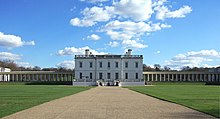Queen's House

The Queen's House is a former royal palace in the London borough of Greenwich .
history
Inigo Jones originally designed the house in 1616 for Anna of Denmark , wife of King James I. However, after the Queen's death, construction ceased in 1619 and Jones built the Banqueting House for the Royal Palace of Whitehall . In 1629 Charles I commissioned Jones to complete the house for his wife Henrietta Maria . The Queen used the house, which was completed in 1635, as a retreat from the nearby Palace of Placentia for her inner court.
Only seven years later (1642) the English Civil War ended the royal use of the house. Under the government of Maria II and Wilhelm III. the old Palace of Placentia was torn down. Christopher Wren was commissioned to build the Greenwich Hospital for seafarers on this site . Maria II, however, gave Wren the instruction to include the Queen's House in this facility and to keep the line of sight to the Thames clear. The current complex with two building complexes opposite each other, which frame the Queens House, was built between 1696 and 1752.
From 1807, Queen's House served as a seaman's school. It has been part of the National Maritime Museum since 1937 . Mainly naval paintings and portraits of personalities from the history of the sea are exhibited in the building.
The Park of Greenwich, including all building was in 1997 as Maritime Greenwich for World Heritage of UNESCO appointed.
architecture
Above the old Palace of Placentia, the public road from Deptford to Woolwich ran through the royal park . To get from the castle to the upper part of the park without having to cross this street, Inigo Jones came up with a clever plan. Two rectangular parts of the building parallel to the street were to form the ground floor, while the first floor was to be connected by a kind of covered bridge. So the street ran through the first floor of the new house. After the road was relocated, Charles II had the sides closed by John Webb in 1661 , so that Queen's House now has a cubic shape. For the new use as a seaman's school, Daniel Asher Alexander erected new side wings to the east and west of the building in 1807 , which were connected to the Queen's House by colonnades .
Queen's House is one of the most important buildings in British architectural history as it was the first Palladian structure in England. Construction began in 1616, but the delay in construction meant that it was not completed until after the Banqueting House, making it the first building in the style of Palladian classicism in England. Inigo Jones had studied the architecture of Andrea Palladio , but the model for Queens House seems to have been Giuliano da Sangallo's Villa Medici in Poggio a Caiano . While the spacious Palace of Placentia with its facade made of red bricks looked rather inconspicuous, the much smaller Queen's House shone in freshly painted white, creating an impressive contrast. With its symmetrical proportions, excellent workmanship and rich interior design, the building is considered a masterpiece of classicism. The understanding of classical architecture was not very widespread in Great Britain at the time and Queen's House appeared to its contemporaries as revolutionary. The building had a style-defining effect and for the next two centuries was considered a model for classicist buildings and mansions throughout England.
Interior decoration
The main room of the house is the cube-shaped Great Hall with a magnificent marble floor made by Nicholas Stone and a carved wooden ceiling. The paintings by Orazio Gentileschi originally in the ceiling were bequeathed by Queen Anne to her lady-in-waiting and temporary confidante Sarah Churchill , who she had installed in her London townhouse, Marlborough House . The famous tulip staircase leads from the Great Hall to the upper floor. The staircase was designed by Jones and is considered the first self-supporting spiral staircase in England. The name comes from the decoration in the railing, which is not supposed to represent tulips, but lilies as a reminiscence of Queen Henrietta Maria from the House of Bourbon . Upstairs are the queen's bedroom and the king's bedroom, and a staircase leads down to the orangery.
Web links
Individual evidence
- ↑ UNESCO World Heritage Center: Maritime Greenwich. Retrieved January 17, 2012 .
Coordinates: 51 ° 28 ′ 52 ″ N , 0 ° 0 ′ 14 ″ W.


